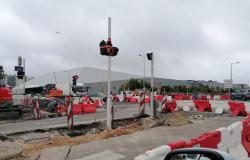In Saint-Projet, Thomas first heard “a dull noise. Then the whole house vibrated.” In Mornac, Antoine was woken up “by jolts before hearing something like an explosion. It banged on the walls in a hyper-violent manner.” In Magnac, Virginie was pulled out of bed by “the little one’s cries. He told me his bed had moved.”
> Find all our articles on earthquakes in our search engine
The Charente shook during the night from Wednesday to Thursday. An earthquake classified as “moderate”: 4.1 on the Richter scale. A wave lasting a few seconds at 3:26 a.m. Then another, weaker, around 4:45. No significant damage to report. The firefighters received a few phone calls but did not have to intervene. Even less significant consequences than in 2019 in South Charente (read box).
Like a shock wave that hit the walls in a hyperviolent way
The epicenter of the earthquake was identified in the Agris sector, “20 km northeast of Angoulême and 53 km east of Cognac”, according to data from the Detection and Geophysics Laboratory. distributed by the Central Seismological Bureau. The tremors were felt over a radius of approximately 50 kilometers. The map drawn up on the basis of 300 testimonies shows that no building was damaged. On the other hand, the intensity is said to be from “weak” to “strong” in the “human perception” category. Mickaël Bonin is a seismologist at the Nantes Atlantique Universe Sciences Observatory (OSUNA). It is the organization which lists seismic phenomena throughout the western region, including Charente.
Muffled noises, explosions…
“At less than 5 on the Richter scale, there is never any real damage, apart from one or two chimneys that can fall. While earthquakes of this intensity are not exceptional, they are rare in this area of France. In Charente, we have less than one per year.” “In Charente, you are far from the mountain ranges where the presence of tectonic plates more often causes this type of event,” continues the seismologist. Nevertheless, measurements are increasingly being carried out in the north-west region as far as Charente. There were 4 measuring stations until 2019. Today we have 30.” Mickaël Bonin provides some explanations on the “thuds”, “thunder”, “planes breaking the sound barrier” or “explosions” heard by the people of Charente just before the tremors. “It’s classic. First there is what is called a P wave (as in first), which causes an intensity on the ground and produces a sound that vibrates the air. Then there is an S wave (as in second), which makes a sort of shearing underground, like waves. That is when the chandeliers and the ornaments shake.
Mickaël Bonin recognizes it, seismologists are helpless to predict this type of event. “We cannot predict small earthquakes in advance. It’s a seismicity that we don’t understand well, unlike the big ones.” 600 earthquakes occur in France every year, but barely 10 to 15 are felt by the population.
The previous ones
Seismologist Mickaël Bonin speaks of a “rare and exceptional phenomenon” for Charente. But there are some precedents. The last one occurred on March 20, 2019. An earthquake of magnitude 4.9 (greater than the one felt during the night from Wednesday to Thursday). The wave hit the south of the department. Light damage: a collapsed chimney in Barbezieux and a few cracks in the Baignes college. In April 2016, an earthquake of magnitude 4.9 hit Charente without causing any damage. Its epicenter was in Charente-Maritime, in Breuil-Magné. Three weeks later, another earthquake (magnitude 3.7, epicenter in Fenioux) took the two Charentes by surprise. The most significant earthquake in the region in the last fifty years occurred in 1972 on the island of Oléron. 5.8 on the Richter scale. The phenomenon caused some material damage.






